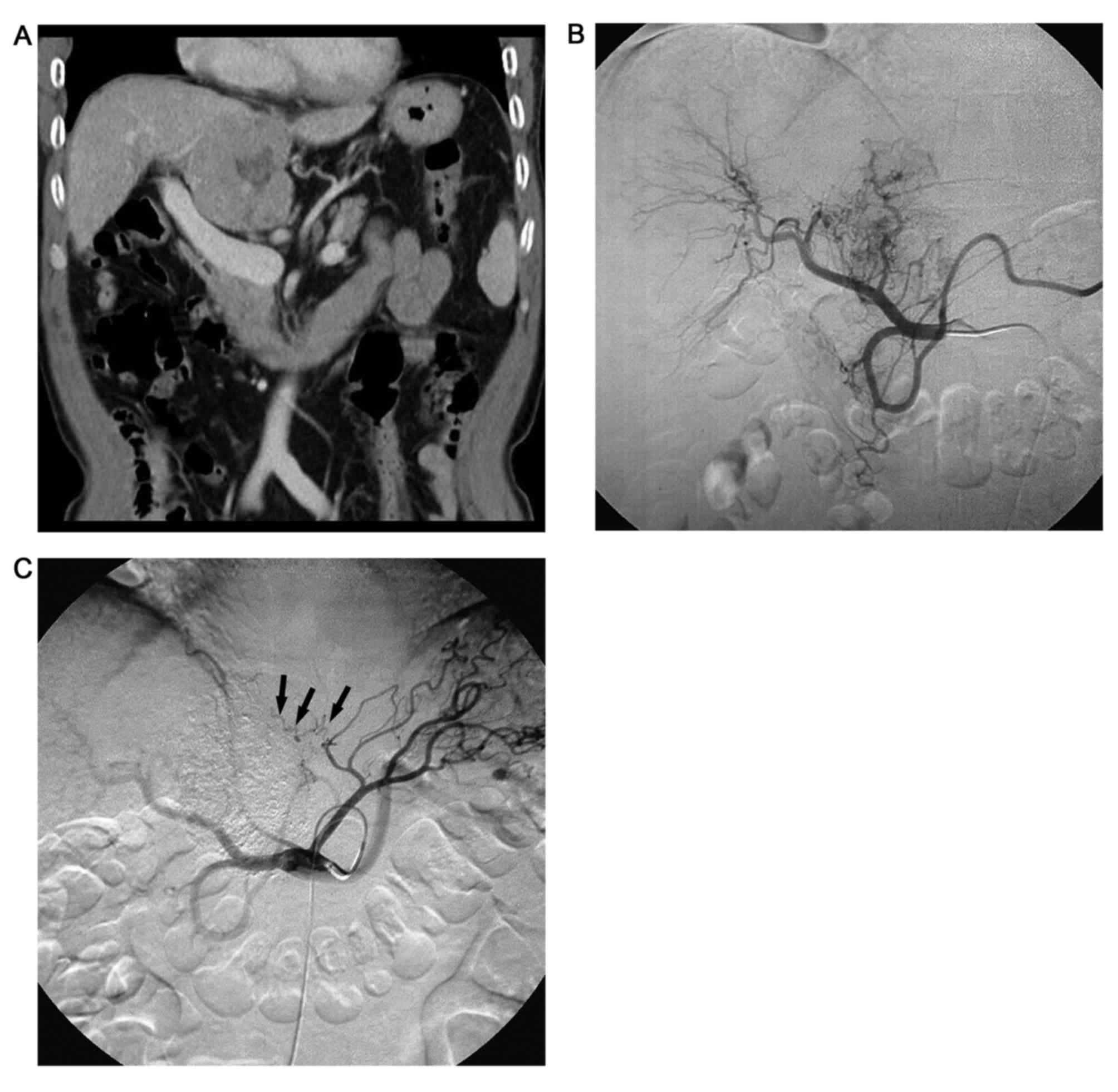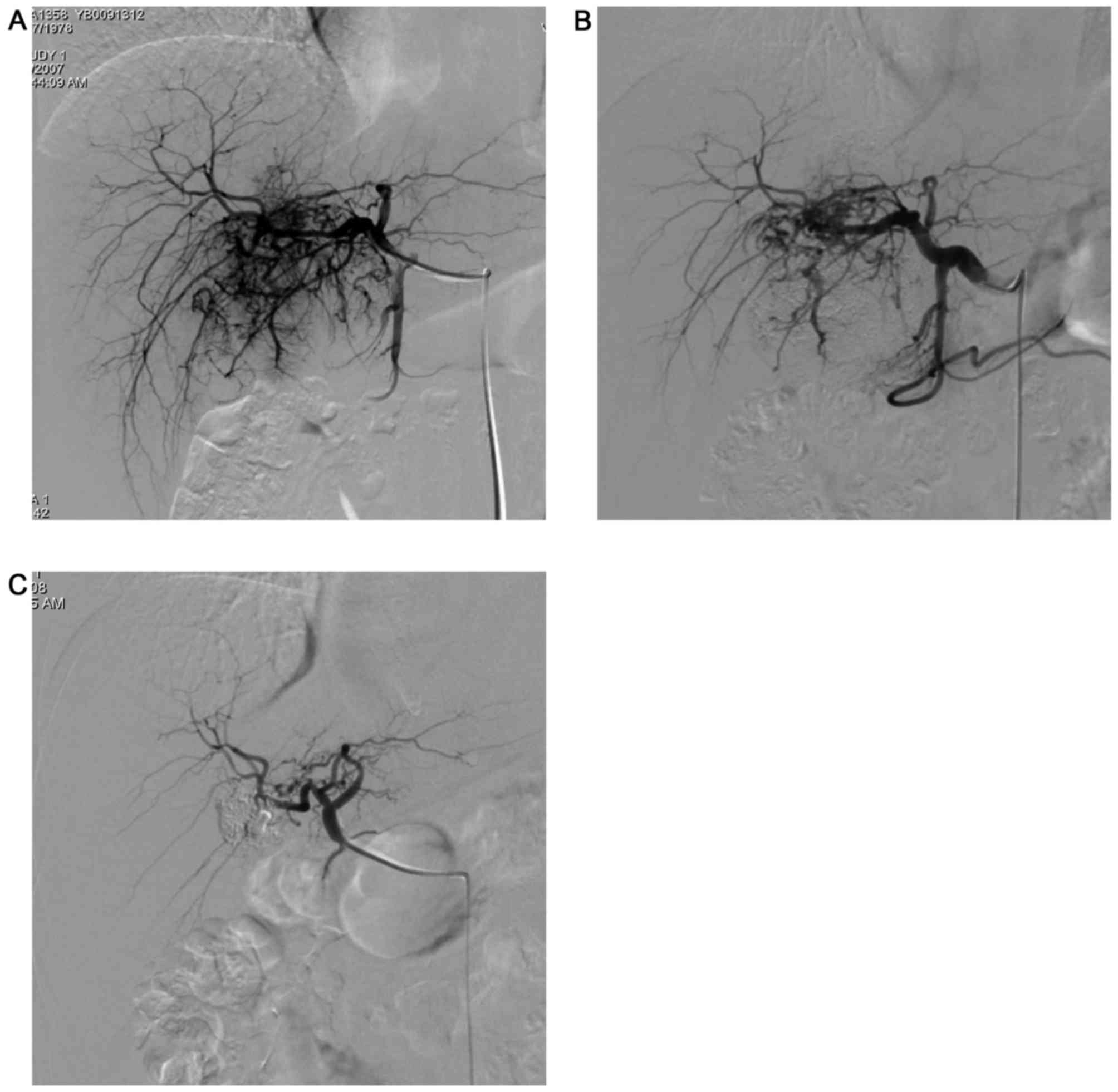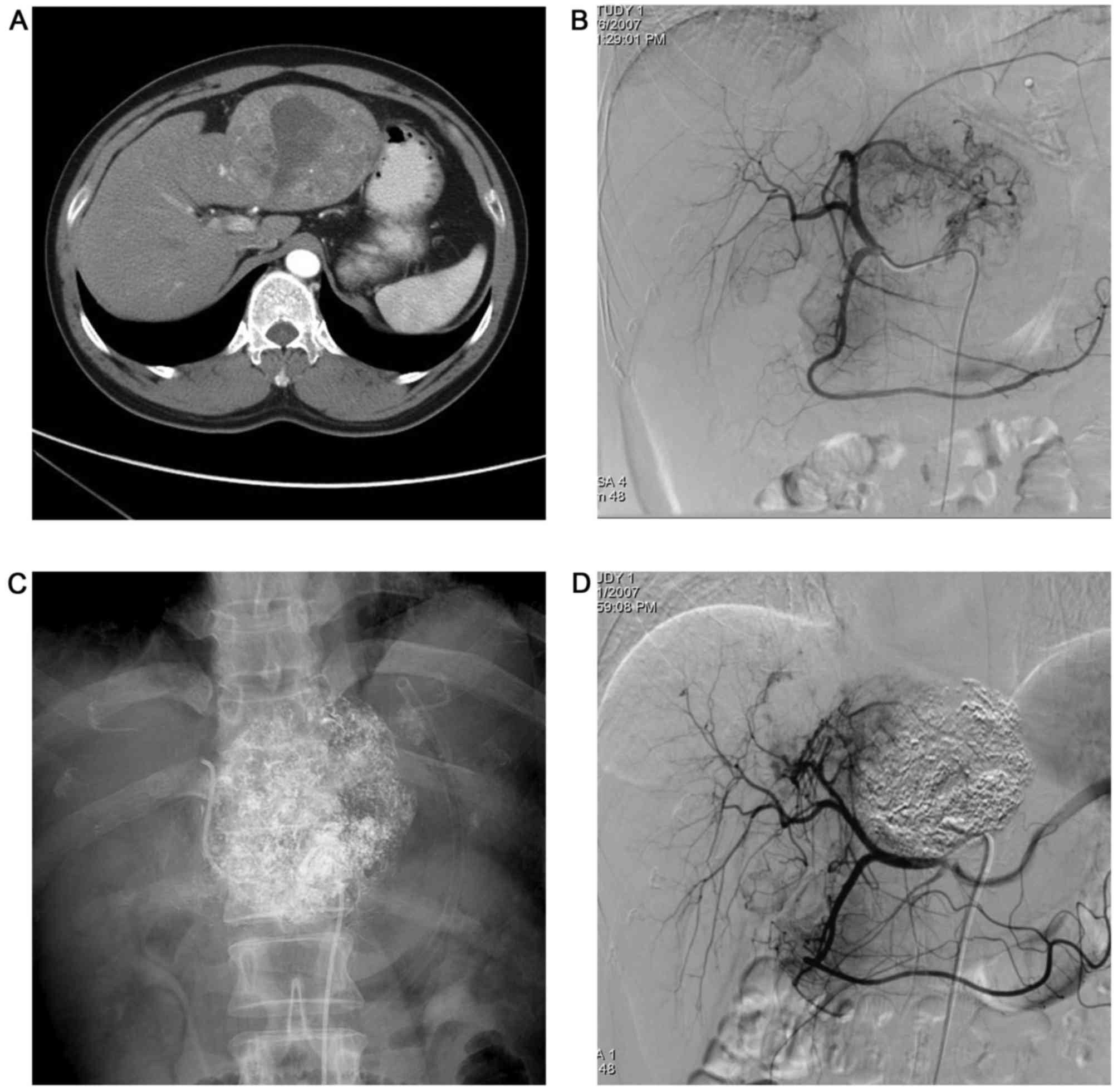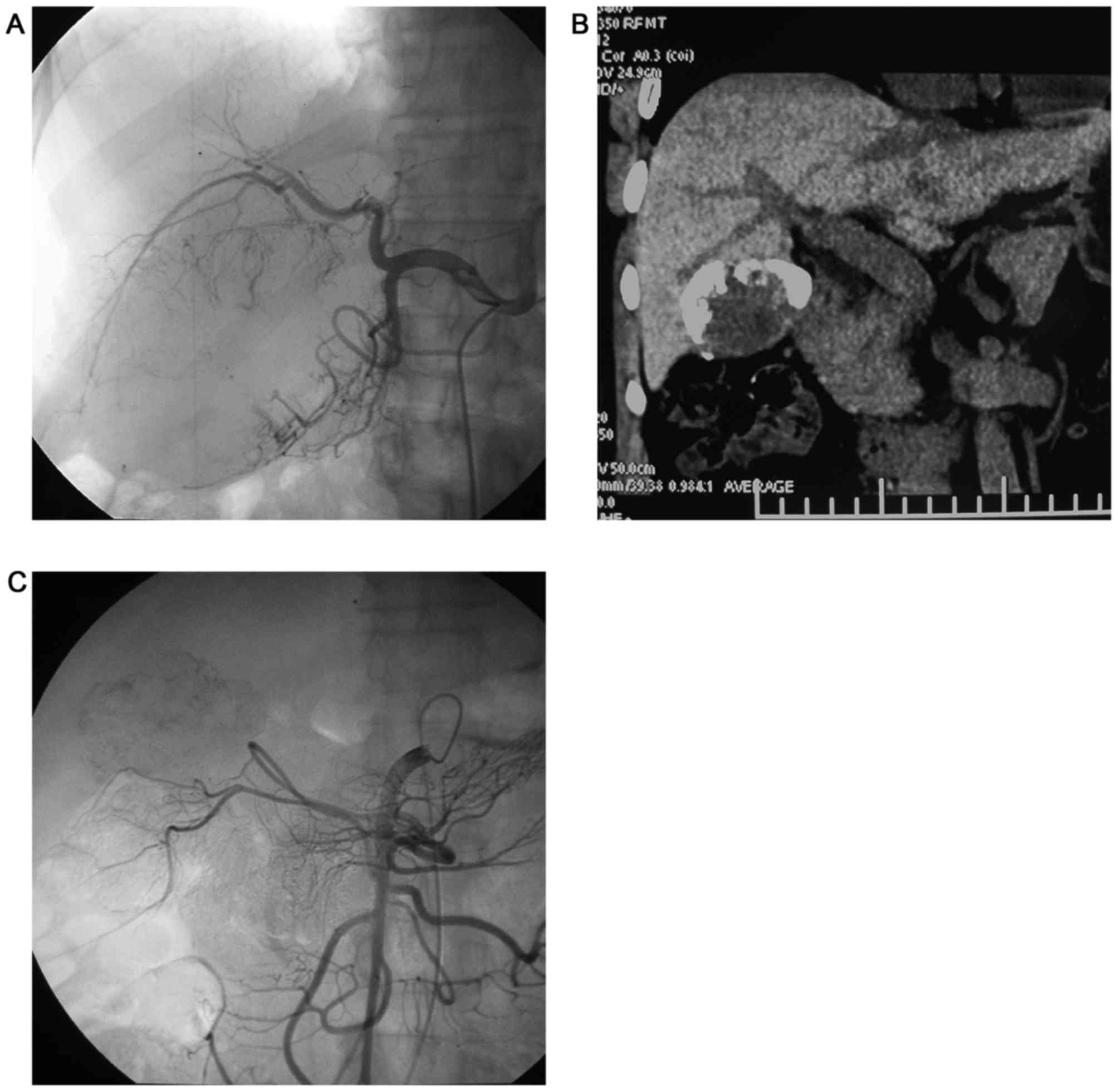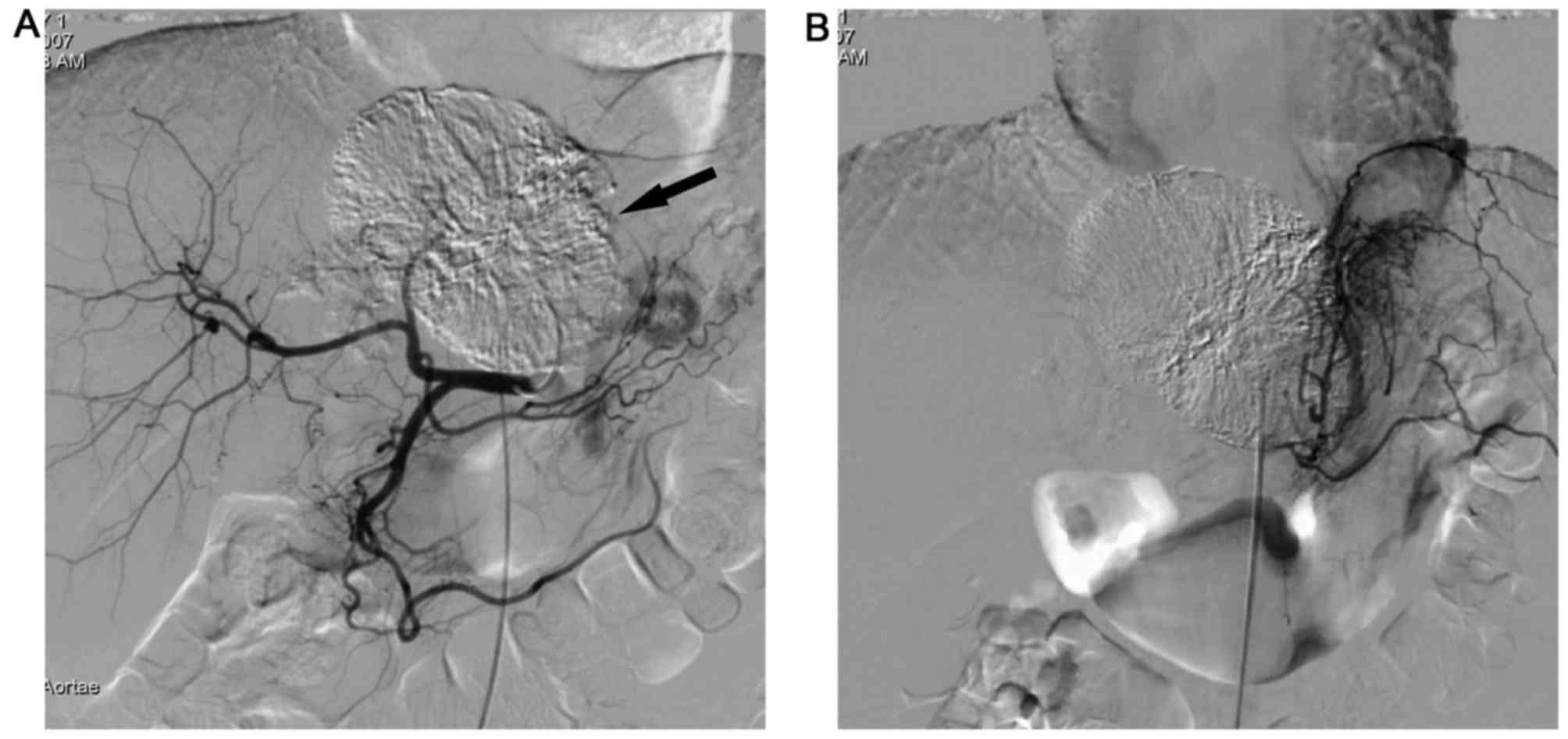|
1
|
Eggel H: Uber das primare Carcinom der
Leber. Beitr Pathol Anat Allg Pathol. 30:506–604. 1901.
|
|
2
|
Roux: Un cas de cancer primitif du foie
avec pericholecystite calculeuse, perforation intestinale:
Hemostase hepatique. Rev Med Suisse Romande. 17:114–119. 1897.
|
|
3
|
Horie Y, Katoh S, Yoshida H, Imaoka T,
Suou T and Hirayama C: Pedunculated hepatocellular carcinoma.
Report of three cases and review of the literature. Cancer.
51:746–751. 1983. View Article : Google Scholar : PubMed/NCBI
|
|
4
|
Horie Y, Shigoku A, Tanaka H, Tomie Y,
Maeda N, Hoshino U, Koda M, Shiota G, Yamamoto T, Kato S, et al:
Prognosis for pedunculated hepatocellular carcinoma. Oncology.
57:23–28. 1999. View Article : Google Scholar : PubMed/NCBI
|
|
5
|
Yeh CN, Lee WC, Jeng LB and Chen MF:
Pedunculated hepatocellular carcinoma: Clinicopathologic study of
18 surgically resected cases. World J Surg. 26:1133–1138. 2002.
View Article : Google Scholar : PubMed/NCBI
|
|
6
|
Moritz MW, Shoji M, Sicard GA, Shioda R
and DeSchryver K: Surgical therapy in two patients with
pedunculated hepatocellular carcinoma. Arch Surg. 123:772–774.
1988. View Article : Google Scholar : PubMed/NCBI
|
|
7
|
Anthony PP and James K: Pedunculated
hepatocellular carcinoma. Is it an entity? Histopatholoy.
11:403–414. 1987.
|
|
8
|
Lopez PM, Villanueva A and Llovet JM:
Systematic review: Evidence-based management of hepatocellular
carcinoma-an updated analysis of randomized controlled trials.
Aliment Pharmacol Ther. 23:1535–1547. 2006. View Article : Google Scholar : PubMed/NCBI
|
|
9
|
Lo CM, Ngan H, Tso WK, Liu CL, Lam CM,
Poon RT, Fan ST and Wong J: Randomized controlled trial of
transarterial lipiodol chemoembolization for unresectable
hepatocellular carcinoma. Hepatology. 35:1164–1171. 2002.
View Article : Google Scholar : PubMed/NCBI
|
|
10
|
Llovet JM, Real MI, Montana X, Planas R,
Coll S, Aponte J, Ayuso C, Sala M, Muchart J, Solà R, et al:
Arterial embolisation or chemoembolisation versus symptomatic
treatment in patients with unresectable hepatocellular carcinoma: A
randomised controlled trial. Lancet. 359:1734–1739. 2002.
View Article : Google Scholar : PubMed/NCBI
|
|
11
|
Yang P, Zeng ZC, Wang BL, Zhang JY, Fan J,
Zhou J and Hu Y: The degree of Lipiodol accumulation can be an
indicator of successful treatment for unresectable hepatocellular
carcinoma (HCC) patients-in the case of transcatheter arterial
chemoembolization (TACE) and external beam radiotherapy (EBRT). J
Cancer. 7:1413–1420. 2016. View Article : Google Scholar : PubMed/NCBI
|
|
12
|
Miyayama S, Matsui O, Taki K, Minami T,
Ryu Y, Ito C, Nakamura K, Inoue D, Notsumata K, Toya D, et al:
Extrahepatic blood supply to hepatocellular carcinoma: Angiographic
demonstration and transcatheter arterial chemoembolization.
Cardiovasc Intervent Radiol. 29:39–48. 2006. View Article : Google Scholar : PubMed/NCBI
|
|
13
|
Yuminaga Y, Kam J and Louie-Johnsun M:
Multi-centre, prospective evaluation of the Seldinger technique for
difficult male urethral catheter insertions by non-urology trained
doctors. BJU Int. 120:(Suppl 3): S21–S27. 2017. View Article : Google Scholar
|
|
14
|
Huang D, Chen Y, Chen S, Zeng Q, Zhao J,
Wu R and Li Y: TACE plus percutaneous chemotherapy-lipiodol
treatment of unresectable pedunculated hepatocellular carcinoma.
Medicine. 96:e76502017. View Article : Google Scholar : PubMed/NCBI
|
|
15
|
Charnsangavej C, Chuang VP, Wallace S, Soo
CS and Bowers T: Angiographic classification of hepatic arterial
collaterals. Radiology. 144:485–494. 1982. View Article : Google Scholar : PubMed/NCBI
|
|
16
|
Michels NA: Collateral arterial pathways
to the liver after ligation of the hepatic artery and removal of
the celiac axis. Cancer. 6:708–724. 1953. View Article : Google Scholar : PubMed/NCBI
|
|
17
|
Koehler RE, Korobkin M and Lewis F:
Arteriographic demonstration of collateral arterial supply to the
liver after hepatic artery ligation. Radiology. 117:49–54. 1975.
View Article : Google Scholar : PubMed/NCBI
|
|
18
|
Miyayama S, Matsui O, Akakura Y, Yamamoto
T, Nishida H, Yoneda K, Kawai K and Nishijima H: Hepatocellular
carcinoma with blood supply from omental branches: Treatment with
transcatheter arterial embolization. J Vasc Interv Radiol.
12:1285–1290. 2001. View Article : Google Scholar : PubMed/NCBI
|
|
19
|
Chung JW, Park JH, Han JK, Choi BI, Kim TK
and Han MC: Transcatheter oily chemoembolization of the inferior
phrenic artery in hepatocellular carcinoma: The safety and
potential therapeutic role. J Vasc Interv Radiol. 9:495–500. 1998.
View Article : Google Scholar : PubMed/NCBI
|
|
20
|
Hirota S, Matsumoto S, Fukuda T, Yoshikawa
T, Motohara T and Ichikawa S: Solitary hepatocellular carcinoma fed
by the cystic artery: Limitation of transcatheter arterial
embolization. Cardiovasc Intervent Radiol. 22:206–209. 1999.
View Article : Google Scholar : PubMed/NCBI
|
|
21
|
Tanigawa N, Sawada S, Okuda Y, Shinzato S,
Mishima K, Asai T, Ohmura N and Kobayashi M: A case of small
hepatocellular carcinoma supplied by the cystic artery. AJR Am J
Roentgenol. 170:675–676. 1998. View Article : Google Scholar : PubMed/NCBI
|
|
22
|
Park SI, Lee DY, Won JY and Lee JT:
Extrahepatic collateral supply of hepatocellular carcinoma by the
intercostal arteries. J Vasc Interv Radiol. 14:461–468. 2003.
View Article : Google Scholar : PubMed/NCBI
|
|
23
|
Soo CS, Chuang VP, Wallace S,
Charnsangavej C and Carrasco H: Treatment of hepatic neoplasm
through extrahepatic collaterals. Radiology. 147:45–49. 1983.
View Article : Google Scholar : PubMed/NCBI
|
|
24
|
Kim JH, Chung JW, Han JK, Park JH, Choi BI
and Han MC: Transcatheter arterial embolization of the internal
mammary artery in hepatocellular carcinoma. J Vasc Interv Radiol.
6:71–77. 1995. View Article : Google Scholar : PubMed/NCBI
|
|
25
|
Duprat G, Charnsangavej C, Wallace S and
Carrasco CH: Inferior phrenic artery embolization in the treatment
of hepatic neoplasms. Acta Radiol. 29:427–429. 1988. View Article : Google Scholar : PubMed/NCBI
|
|
26
|
Nakai M, Sato M, Kawai N, Minamiguchi H,
Masuda M, Tanihata H, Takeuchi T, Terada M and Kishi K:
Hepatocellular carcinoma: Involvement of the internal mammary
artery. Radiology. 219:147–152. 2001. View Article : Google Scholar : PubMed/NCBI
|
|
27
|
Kodama Y, Shimizu T, Endo H, Hige S,
Kamishima T, Holland GA, Miyamoto N and Miyasaka K: Spontaneous
rupture of hepatocellular carcinoma supplied by the right renal
capsular artery treated by transcatheter arterial embolization.
Cardiovasc Intervent Radiol. 25:137–140. 2002. View Article : Google Scholar : PubMed/NCBI
|
|
28
|
Miyayama S, Matsui O, Nishida H, Yamamori
S, Minami T, Shinmura R, Kozaka K, Notsumata K, Toya D, Tanaka N,
et al: Transcatheter arterial chemoembolization for unresectable
hepatocellular carcinoma fed by the cystic artery. J Vasc Interv
Radiol. 14:1155–1161. 2003. View Article : Google Scholar : PubMed/NCBI
|
|
29
|
Miyayama S, Matsui O, Taki K, Minami T,
Ito C, Shinmura R, Takamatsu S, Kobayashi M, Notsumata K, Toya D,
et al: Transcatheter arterial chemoembolization for hepatocellular
carcinoma fed by the reconstructed inferior phrenic artery:
Anatomical and technical analysis. J Vasc Interv Radiol.
15:815–823. 2004. View Article : Google Scholar : PubMed/NCBI
|
|
30
|
Nishizaki T, Matsumata T, Adachi E,
Hayashi H and Sugimachi K: Pedunculated hepatocellular carcinoma
and surgical treatment. Br J Cancer. 67:115–118. 1993. View Article : Google Scholar : PubMed/NCBI
|
|
31
|
Chung GE, Lee JH, Kim HY, Hwang SY, Kim
JS, Chung JW, Yoon JH, Lee HS and Kim YJ: Transarterial
chemoembolization can be safely performed in patients with
hepatocellular carcinoma invading the main portal vein and may
improve the overall survival. Radiology. 258:627–634. 2011.
View Article : Google Scholar : PubMed/NCBI
|
|
32
|
Becher G, Sozgen T, Olschewski M,
Laubenberger J, Blum HE and Allgaier HP: Combined TACE and PEI for
paliative treatment of unresectable hepatocellular carcinoma. World
J Gastroenterol. 11:6104–6109. 2005. View Article : Google Scholar : PubMed/NCBI
|



